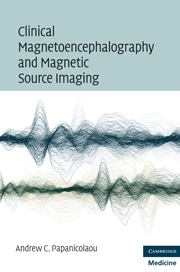Book contents
- Frontmatter
- Contents
- Contributors
- Preface
- Section 1 The method
- Section 2 Spontaneous brain activity
- Section 3 Evoked magnetic fields
- Postscript: Future applications of clinical MEG
- Overview
- Normal aging and neurodegenerative disorders
- Neurodevelopmental disorders
- Psychiatric disorders
- Neurological disorders
- Functional reorganization
- References
- Index
Neurodevelopmental disorders
from Postscript: Future applications of clinical MEG
Published online by Cambridge University Press: 01 March 2010
- Frontmatter
- Contents
- Contributors
- Preface
- Section 1 The method
- Section 2 Spontaneous brain activity
- Section 3 Evoked magnetic fields
- Postscript: Future applications of clinical MEG
- Overview
- Normal aging and neurodegenerative disorders
- Neurodevelopmental disorders
- Psychiatric disorders
- Neurological disorders
- Functional reorganization
- References
- Index
Summary
Fetal MEG
One of the most novel applications of MEG has been the imaging of fetal cortical activity. The possibility of characterizing anomalies in neural function early in gestation may aid in the early detection of abnormal development. Advances in multichannel SQUID design have led to the development of sophisticated techniques capable of measuring brain function in utero while isolating myogenic artifacts emanating from the fetal and maternal heart, as well as the uterus. Though small in number, several studies have hinted at the potential for recording both evoked and spontaneous fetal MEG. The main finding in fetal MEG studies to date has been the successful recording of the auditory evoked response, first accomplished by Blum and colleagues in 1985 using a single-channel recording unit. Over the course of several studies, other researchers, using pure tone stimulation, have characterized the fetal analogue to the M100 auditory evoked-response component as occurring at latencies ranging from ~125 to ~200 ms and amplitudes ranging from ~30 to ~175 fT. Other investigators measured the fetal auditory evoked field but reported different latency ranges. Though not as stable as auditory, visual evoked responses also have been recorded in fetuses. Fetal visual evoked responses peaked at ~200 ms in about 58% of fetuses as early as the third trimester of pregnancy (28 weeks) and decreased (poststimulus) with an increase in gestational age. Furthermore, spontaneous fetal activity recorded by Eswaran and colleagues showed evidence of the process of maturation similar to EEG results for preterm babies born within the third trimester.
- Type
- Chapter
- Information
- Clinical Magnetoencephalography and Magnetic Source Imaging , pp. 178 - 182Publisher: Cambridge University PressPrint publication year: 2009

